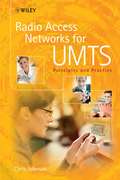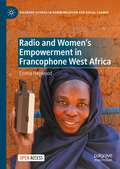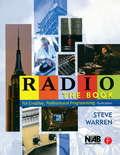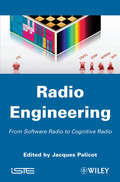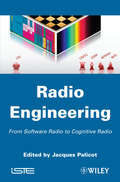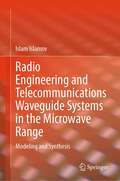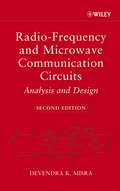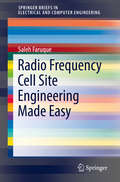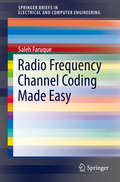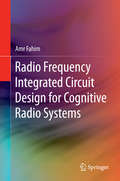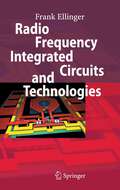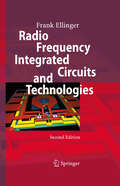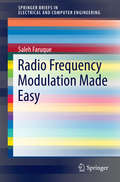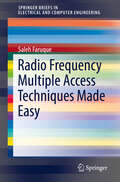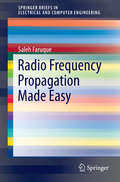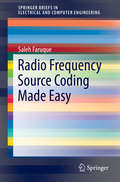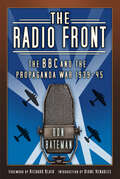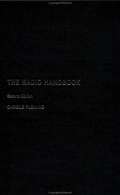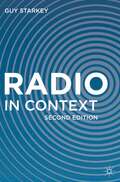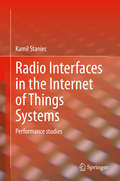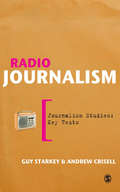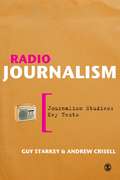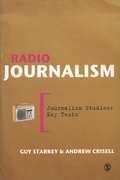- Table View
- List View
Radio Access Networks for UMTS: Principles and Practice
by Chris JohnsonThis book provides a comprehensive description of Radio Access Networks for UMTS . The main content is based upon the release 6 version of the 3GPP specifications. Changes since the release 99 version are described while some of the new features from the release 7 version are introduced. Starting from the high-level network architecture, the first sections describe the flow of data between the network and end-user. This includes a dedicated chapter describing the Iub transport network. Detailed descriptions of both HSDPA and HSUPA reflect the increasing importance of efficient high data rate connections. Signalling procedures are described for speech, video and PS data connection establishment, SMS data transfer, soft handover and inter-system handover. The more practical subjects of link budgets and radio network planning are also addressed. More than 180 example log files reinforce the reader's understanding Summary bullet points allow rapid access to the most important information Focus upon how data is transferred between the network and end-user Dedicated chapters provide detailed descriptions of both HSDPA and HSUPA Step-by-step analysis of common signalling procedures Key radio network planning subjects addressed Radio Access Networks for UMTS is ideal for mobile telecommunications engineers working for equipment vendors, operators and regulators. It will also appeal to system designers, technical managers and students.
Radio and Women's Empowerment in Francophone West Africa (Palgrave Studies in Communication for Social Change)
by Emma HeywoodThis open access book breaks new ground by examining the significant role played by radio in empowering women in three Francophone West African countries: Mali, Niger and Burkina Faso.It examines the representation and perception of key themes broadcast by radio and associated with women’s empowerment in the three countries. Each chapter contextualises a specific topic in the country and then explores discrete aspects of radio’s provision. The topics covered in the chapters are women’s political engagement; women and finances; women and life within marriage; inheritance; women’s involvement in radio structures; and radio, internally displaced women, and trauma.Given the social, economic and political vulnerability and deteriorating security situation of the three countries, this book provides a timely and meaningful contribution to acknowledging and understanding the vital role of radio in women’s empowerment.
Radio: The Book
by Steve WarrenAs entertaining as it is educational, Radio: The Book is a must-have guide to success for anyone interested in a career in radio. Providing a wealth of information and relating his own personal experiences, veteran radio personality, Program Director and Programming Consultant Steve Warren shares trade secrets and industry know-how that would usually take years to accumulate through experience. An invaluable advantage over your competition, this "cheat-sheet" for the radio programmer includes practical advice regarding:·Radio as a career--from tips on getting started to job negotiations·Programming--talk radio and music, from format science to picking the hits·Relationships with listeners--everything from staying in touch with your audience to public image·Branding, marketing, and advertising the radio station·Research--music tests, audience analysis, ratings, and more·Practical information about management policies·Radio realities--information on rules and regulationsThis latest edition has been updated to include: ·Important updates on an ever-evolving field·Essential forms for radio station functions--production orders, personnel files, absentee reports, PSA schedules, format clocks, remote schedule, and more.to be accompanied by an on-line section of electronic forms for convenience·Ideas for successfully programming in new radio formats like satellite, internet, and cableIn such a competitive industry where formal training can be hard to come by, Radio: The Book, 4e, is a short-cut to the fast track for current and future programmers and program directors. With an active radio broadcast career that is still exploring new ideas following s more than forty years at some of America's most prestigious radio stations (including WNBC, WHN, WNEW, and CBS radio), Steve Warren is more than qualified to mentor readers. Steve has competed successfully in all music formats from Easy Listening to Country to Top 40 to Oldies, always putting the listener first and now, putting you first.
Radio: The Book
by Steve WarrenAs entertaining as it is educational, Radio: The Book is a must-have guide to success for anyone interested in a career in radio. Providing a wealth of information and relating his own personal experiences, veteran radio personality, Program Director and Programming Consultant Steve Warren shares trade secrets and industry know-how that would usually take years to accumulate through experience. An invaluable advantage over your competition, this "cheat-sheet" for the radio programmer includes practical advice regarding:·Radio as a career--from tips on getting started to job negotiations·Programming--talk radio and music, from format science to picking the hits·Relationships with listeners--everything from staying in touch with your audience to public image·Branding, marketing, and advertising the radio station·Research--music tests, audience analysis, ratings, and more·Practical information about management policies·Radio realities--information on rules and regulationsThis latest edition has been updated to include: ·Important updates on an ever-evolving field·Essential forms for radio station functions--production orders, personnel files, absentee reports, PSA schedules, format clocks, remote schedule, and more.to be accompanied by an on-line section of electronic forms for convenience·Ideas for successfully programming in new radio formats like satellite, internet, and cableIn such a competitive industry where formal training can be hard to come by, Radio: The Book, 4e, is a short-cut to the fast track for current and future programmers and program directors. With an active radio broadcast career that is still exploring new ideas following s more than forty years at some of America's most prestigious radio stations (including WNBC, WHN, WNEW, and CBS radio), Steve Warren is more than qualified to mentor readers. Steve has competed successfully in all music formats from Easy Listening to Country to Top 40 to Oldies, always putting the listener first and now, putting you first.
Radio Design in Nanometer Technologies
by Mohammed Ismail Delia R. De Llera GonzálezRadio Design in Nanometer Technologies is the first volume that looks at the integrated radio design problem as a "piece of a big puzzle", namely the entire chipset or single chip that builds an entire wireless system. This is the only way to successfully design radios to meet the stringent demands of today’s increasingly complex wireless systems.
Radio Engineering: From Software Radio to Cognitive Radio
by Jacques PalicotSoftware radio ideally provides the opportunity to communicate with any radio communication standard by modifying only the software, without any modification to hardware components. However, taking into account the static behavior of current communications protocols, the spectrum efficiency optimization, and flexibility, the radio domain has become an important factor. From this thinking appeared the cognitive radio paradigm. This evolution is today inescapable in the modern radio communication world. It provides an autonomous behavior to the equipment and therefore the adaptation of communication parameters to better match their needs. This collective work provides engineers, researchers and radio designers with the necessary information from mathematical analysis and hardware architectures to design methodology and tools, running platforms and standardization in order to understand this new cognitive radio domain.
Radio Engineering: From Software Radio to Cognitive Radio (Lecture Notes Of The Institute For Computer Sciences, Social Informatics And Telecommunications Engineering Ser. #172)
by Jacques Palicot Pierre‐Noël FavennecSoftware radio ideally provides the opportunity to communicate with any radio communication standard by modifying only the software, without any modification to hardware components. However, taking into account the static behavior of current communications protocols, the spectrum efficiency optimization, and flexibility, the radio domain has become an important factor. From this thinking appeared the cognitive radio paradigm. This evolution is today inescapable in the modern radio communication world. It provides an autonomous behavior to the equipment and therefore the adaptation of communication parameters to better match their needs. This collective work provides engineers, researchers and radio designers with the necessary information from mathematical analysis and hardware architectures to design methodology and tools, running platforms and standardization in order to understand this new cognitive radio domain.
Radio Engineering and Telecommunications Waveguide Systems in the Microwave Range: Modeling and Synthesis
by Islam IslamovThe book systematizes numerical methods for modelling and synthesizing radio engineering and telecommunication systems in the microwave range of rectangular and circular waveguides. The author gives the theoretical foundations for the analysis and optimal synthesis of these systems and presents the results of new research. The book uses the HFSS complex to analyse, optimize, and synthesize microwave systems operating on E-type and H-type waves while providing the outcomes. As a result of analysis and synthesis, various microwave devices with improved technical and operational parameters have been developed, and on their basis a new system of waveguide paths is proposed that connects the transmitter and antenna in TV towers. The book is intended for engineers and scientists involved in the design of radio engineering and telecommunication systems.
Radio-Frequency and Microwave Communication Circuits: Analysis and Design
by Devendra K. MisraThe products that drive the wireless communication industry, such as cell phones and pagers, employ circuits that operate at radio and microwave frequencies. Following on from a highly successful first edition, the second edition provides readers with a detailed introduction to RF and microwave circuits. Throughout, examples from real-world devices and engineering problems are used to great effect to illustrate circuit concepts. * Takes a top-down approach, describing circuits in the overall context of communication systems. * Presents expanded coverage of waveguides and FT mixers. * Discusses new areas such as oscillators design and digital communication. *An Instructor's Manual presenting detailed solutions to all the problems in the book is available from the Wiley editorial department.
Radio Frequency Cell Site Engineering Made Easy (SpringerBriefs in Electrical and Computer Engineering)
by Saleh FaruqueThis book introduces Radio Frequency Cell Site Engineering to a broad audience. The author blends theory and practice to bring readers up-to-date in key concepts, underlying principles and practical applications of wireless communications. The presentation is designed to be easily accessible, minimizing mathematics and maximizing visuals.
Radio Frequency Channel Coding Made Easy (SpringerBriefs in Electrical and Computer Engineering)
by Saleh FaruqueThis book introduces Radio Frequency Channel Coding to a broad audience. The author blends theory and practice to bring readers up-to-date in key concepts, underlying principles and practical applications of wireless communications. The presentation is designed to be easily accessible, minimizing mathematics and maximizing visuals.
Radio Frequency Integrated Circuit Design for Cognitive Radio Systems
by Amr FahimThis book fills an information gap on cognitive radios, since the discussion focuses on the implementation issues that are unique to cognitive radios and how to solve them at both the architecture and circuit levels. This is the first book to describe in detail cognitive radio systems, as well as the circuit implementation and architectures required to implement such systems. Throughout the book, requirements and constraints imposed by cognitive radio systems are emphasized when discussing the circuit implementation details. This is a valuable reference for anybody with background in analog and radio frequency (RF) integrated circuit design, needing to learn more about integrated circuits requirements and implementation for cognitive radio systems.
Radio Frequency Integrated Circuits and Technologies
by Frank EllingerThe striking feature of this book is its coverage of the upper GHz domain. However, the latest technologies, applications and broad range of circuits are discussed. Design examples are provided including cookbook-like optimization strategies. This state-of-the-art book is valuable for researchers as well as for engineers in industry. Furthermore, the book serves as fruitful basis for lectures in the area of IC design.
Radio Frequency Integrated Circuits and Technologies
by Frank EllingerThe striking feature of this book is its coverage of the upper GHz domain. However, the latest technologies, applications and broad range of circuits are discussed. Design examples are provided including cookbook-like optimization strategies. This state-of-the-art book is valuable for researchers as well as for engineers in industry. Furthermore, the book serves as fruitful basis for lectures in the area of IC design.
Radio Frequency Modulation Made Easy (SpringerBriefs in Electrical and Computer Engineering)
by Saleh FaruqueThis book introduces Radio Frequency Modulation to a broad audience. The author blends theory and practice to bring readers up-to-date in key concepts, underlying principles and practical applications of wireless communications. The presentation is designed to be easily accessible, minimizing mathematics and maximizing visuals.
Radio Frequency Multiple Access Techniques Made Easy (SpringerBriefs in Electrical and Computer Engineering)
by Saleh FaruqueThis book provides a comprehensive overview of multiple access techniques used in the cellular industry. The usage of multiple access techniques in telecommunications enables many users to share the same spectrum in the frequency domain, time domain, code domain or phase domain. Licenses are given, by the FCC, to operate wireless communication systems over given bands of frequencies, with the smaller bands, (channels), reused to provide services to other users. Thus, bandwidth efficiency is vital, as the speed and size of digital data networks continue to expand. This brief also uses numerous illustrations to bring students up-to-date in the practical applications of multiple access techniques, which can then be put to work in the industry. Primarily, electrical engineering students who study telecommunications, as well as engineers and designers working in wireless communications, would find this book useful.
Radio Frequency Propagation Made Easy (SpringerBriefs in Electrical and Computer Engineering)
by Saleh FaruqueThis book introduces Radio Frequency Propagation to a broad audience. The author blends theory and practice to bring readers up-to-date in key concepts, underlying principles and practical applications of wireless communications. The presentation is designed to be easily accessible, minimizing mathematics and maximizing visuals.
Radio Frequency Source Coding Made Easy (SpringerBriefs in Electrical and Computer Engineering)
by Saleh FaruqueThis book introduces Radio Frequency Source Coding to a broad audience. The author blends theory and practice to bring readers up-to-date in key concepts, underlying principles and practical applications of wireless communications. The presentation is designed to be easily accessible, minimizing mathematics and maximizing visuals.
The Radio Front: The BBC and the Propaganda War 1939-45
by Ron BatemanWithin seventeen years of the first public broadcast in Britain, the nation again found itself at war. As the Second World War progressed, the BBC eventually realised the potential benefits of public radio and the service became vital in keeping an anxious public informed, upbeat and entertained behind the curtains of millions of blacked-out homes. The Radio Front examines just how the BBC reinvented itself and delivered its carefully controlled propaganda to listeners in the UK and throughout Nazi-occupied Europe. It also reveals the BBC’s often-strained relationships with the government, military and public as the organisation sought to influence opinion and safeguard public morale without damaging its growing reputation for objectivity and veracity.Using original source material, historian and author Ron Bateman tracks the BBC’s growth during the Second World War from its unorganised and humble beginnings to the development of a huge overseas and European operation, and also evaluates the importance of iconic broadcasts from the likes of J.B. Priestley, Vera Lynn and Tommy Handley.
The Radio Handbook (PDF)
by Carole FlemingThe Radio Handbook is a comprehensive guide to radio broadcasting in Britain. Completely rewritten and updated for the second edition, using new examples, case studies and illustrations, it examines the various components that make radio, from music selection to news presentation, and from phone-ins to sports programmes. Carole Fleming explores the extraordinary growth of commercial radio, analyses the birth of digital audio broadcasting and Internet radio and evaluates their effects on the industry. The Radio Handbook shows how communication theory informs everyday broadcasts and encourages a critical approach to radio listening and to radio practice. Addressing issues of regulation, accountability and representation, it offers advice on working in radio and outlines the skills needed for a career in the industry. The Radio Handbook includes: Interviews with people working at all levels in the industry, including programme controllers, news presenters and DJs Examples of programming, including nationwide and local BBC, commercial radio, community and student stations Chapters on radio style, the role of news, getting started in radio and the tools of broadcasting A glossary of key terms and technical concepts The Radio Handbook is a comprehensive guide to radio broadcasting in Britain. Completely rewritten and updated for the second edition, using new examples, case studies and illustrations, it examines the various components that make radio, from music selection to news presentation, and from phone-ins to sports programmes. Carole Fleming explores the extraordinary growth of commercial radio, analyses the birth of digital audio broadcasting and Internet radio and evaluates their effects on the industry.
Radio in Context
by Guy StarkeyNow firmly established as one of the leading textbooks in the increasingly popular field of radio studies, Radio in Context provides students with a practical, critical and comprehensive understanding of the main principles and techniques used in radio programming. Organized around the most commonly studied radio genres and setting production within a range of different contexts – professional, institutional and historical - the text offers an ideal blend of theory and practical guidance. Readers of this fully updated new edition will continue to benefit from this core text, as it reflects important technological, regulatory and institutional changes since its initial publication in 2004 and expands on key areas such as digital radio, broadcasting over the internet, and the interplay between radio and social media. Supported by a full glossary, tips on getting into radio and exercises to develop practical and critical skills, Radio in Context is the ideal companion for anyone studying radio, the media, communications and/or journalism, at undergraduate and postgraduate levels, as well as short courses in radio or audio production techniques.Now firmly established as one of the leading textbooks in the increasingly popular field of radio studies, Radio in Context provides students with a practical, critical and comprehensive understanding of the main principles and techniques used in radio programming. Organized around the most commonly studied radio genres and setting production within a range of different contexts – professional, institutional and historical - the text offers an ideal blend of theory and practical guidance. Readers of this fully updated new edition will continue to benefit from this core text, as it reflects important technological, regulatory and institutional changes since its initial publication in 2004 and expands on key areas such as digital radio, broadcasting over the internet, and the interplay between radio and social media. Supported by a full glossary, tips on getting into radio and exercises to develop practical and critical skills, Radio in Context is the ideal companion for anyone studying radio, the media, communications and/or journalism, at undergraduate and postgraduate levels, as well as short courses in radio or audio production techniques.
Radio Interfaces in the Internet of Things Systems: Performance studies
by Kamil StaniecThe book gives a broad overview of the Internet of Things (IoT) concept from various angles. The book provides rationale for: the concept development; its regulatory and technical background associated aspects such as the ambient and edge intelligence; fog computing; capillary networks and machine-type communications; etc. Each of these items is then extended in further respective chapters that deal with technicalities behind them. Chapters: 2-5, 8, 10-11 are addressed to those who seek expository IoT-related information on aspects such as the pathloss calculation, narrowband radio interfaces, radiation masks, spectrum matters, medium access control, and a transmission frame construction. That section ends with an exhaustive description of the six most popular IoT systems: LoRa, Weightless, SigFox, NB-IoT, LTE-M(TC) and EC-GSM IoT. Specialists and network designers may find chapters 6 and 7 interesting where a novel methodology is proposed for testing narrowband IoT systems performance for immunity to electromagnetic interference (EMI) and multipath propagation, both emulated in artificial conditions of the anechoic and the reverberation chamber.
Radio Journalism
by Andrew Crisell Professor Guy Starkey"This is not another turgid guide to digital editing, writing for radio and the structure of a newsroom team. It is an ambitious and accessible study that combines a succinct narrative history of radio journalism with an analysis of its power in the public sphere. It describes the development of British audio broadcasting before locating it in an international context and contemplating the contours of the convergent future. Such ambition is often the prelude to failure. Instead, Starkey and Crisell have written a precious introduction to the theory, practice and purposes of radio journalism that will be very useful to serious students of the subject... This is a very good book." - THE (Times Higher Education) Radio Journalism introduduces key themes in journalism studies to explore what makes radio reporting distinctive and lay out the claims for radio's critical importance in the news landscape. With their extensive experience in radio production and academica, authors Guy Starkey and Andrew Crisell take readers on a tour through the past, present and future of radio broadcasting, from the infancy of the BBC in the 1920s up to the prospect of rolling news delivered to mobile telephones. Grounding each chapter in a survey of scholarly writing on the radio, they explore the connections between politics, policy and practice, inviting critical reflection on who radio professionals are, what they do and why. Putting theory and practice into dialogue, this book is the perfect bridge between unreflective production manuals and generalised media theory texts. Witty and engaging, Radio Journalism provides an essential framework for understanding the continuing relevance of radio journalism as a profession, set of practices and arena for critical debate.
Radio Journalism (PDF)
by Andrew Crisell Professor Guy Starkey"This is not another turgid guide to digital editing, writing for radio and the structure of a newsroom team. It is an ambitious and accessible study that combines a succinct narrative history of radio journalism with an analysis of its power in the public sphere. It describes the development of British audio broadcasting before locating it in an international context and contemplating the contours of the convergent future. Such ambition is often the prelude to failure. Instead, Starkey and Crisell have written a precious introduction to the theory, practice and purposes of radio journalism that will be very useful to serious students of the subject. . . This is a very good book. " - THE (Times Higher Education) Radio Journalism introduduces key themes in journalism studies to explore what makes radio reporting distinctive and lay out the claims for radio's critical importance in the news landscape. With their extensive experience in radio production and academica, authors Guy Starkey and Andrew Crisell take readers on a tour through the past, present and future of radio broadcasting, from the infancy of the BBC in the 1920s up to the prospect of rolling news delivered to mobile telephones. Grounding each chapter in a survey of scholarly writing on the radio, they explore the connections between politics, policy and practice, inviting critical reflection on who radio professionals are, what they do and why. Putting theory and practice into dialogue, this book is the perfect bridge between unreflective production manuals and generalised media theory texts. Witty and engaging, Radio Journalism provides an essential framework for understanding the continuing relevance of radio journalism as a profession, set of practices and arena for critical debate.
Radio Journalism (PDF)
by Guy StarkeyRadio Journalism introduduces key themes in journalism studies to explore what makes radio reporting distinctive and lay out the claims for radio's critical importance in the news landscape.
